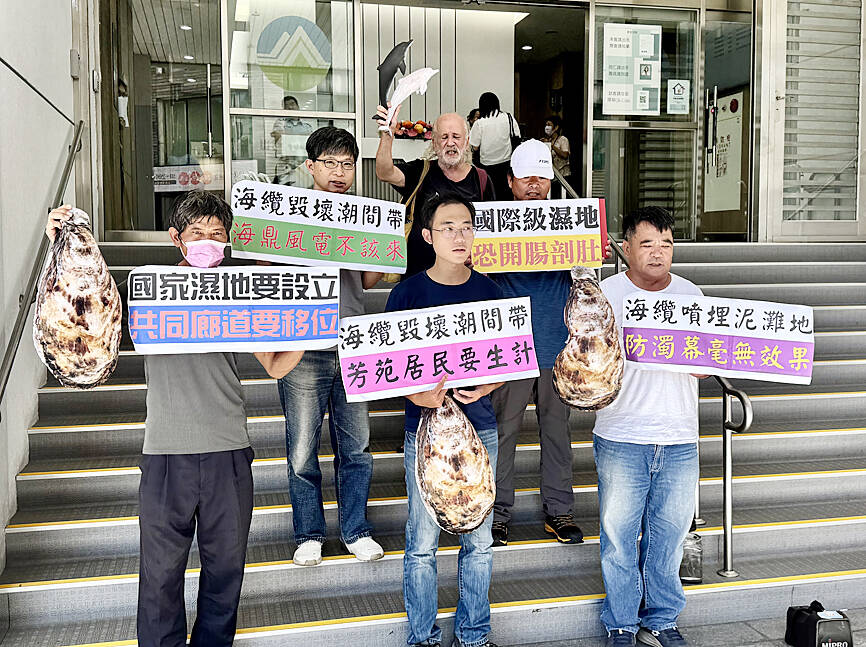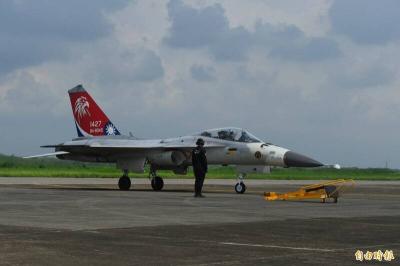Environmental groups yesterday rallied in front of the Ministry of Environment in Taipei to protest proposed revisions to an approved offshore wind power project, saying the underwater export cables planned to run through the intertidal zone in Changhua County’s Fangyuan Township (芳苑) would disrupt local ecosystems and aquaculture industries.
The original version of the project passed an environmental impact assessment (EIA) in 2018, but revisions were made to change the project area, wind turbine unit capacity and locations of onshore points of interconnection (POI) for export cables. An EIA review of the revised version began in November last year.
The proposed revisions have provoked outcry among local fishers and environmental advocates, as the planned POI locations were moved southward and would lead underwater cables through the intertidal zone in the township, a region known for oyster and hard-shell clam farming.

Photo: Huang Yi-ching, Taipei Times
Local fishery worker Lee Kuo-chung (李國忠) said the construction of wind turbines in a previous project produced murky seawater and caused a drastic decline in intertidal species, leading to great financial losses to oyster farmers.
Local oyster farmer Hung Chiu-yueh (洪秋岳) said that oysters used to grow mature enough within one and a half years, but none could be harvested in his farms for at least three years since the wind turbine construction started.
Wild at Heart Legal Defense Association researcher Hong Shuo-cheng (洪碩辰) said the intertidal zone along the county’s coast extends up to 6km, which is unique and unmatched by any other coastline in Taiwan.
However, the government in 2017 included the region as one of the two “corridors” for sea-to-shore cables of wind power turbines without thorough on-site exploration and planning, he said, urging the EIA committee to veto the revised project.
At the third EIA meeting yesterday, concerns were raised not only about the project’s impact on local ecosystems, but also the fact that part of the proposed installed capacity has yet to be approved by the Ministry of Economic Affairs (MOEA).
The county government said the developer failed to assess the environmental impact of the project’s export cable construction on the intertidal zone and marine life, as the EIA of the changed cable routes was missing in the report.
The EIA committee said the proposed project area and installed capacity should agree with those specified in previously submitted documents.
The developer is advised to obtain MOEA approval for the proposed capacity before it sends the EIA report to the committee for review, it said.
The committee also asked the developer to include details on the scope, timeline and method of constructing sea-to-shore cables, as well as the construction process’ impact on the intertidal zone.
The developer should also refrain from setting up POI locations within the intertidal zone along the township’s coast and engage in more active communication with local residents, it said.
The committee concluded that the proposal should be revised and submitted with supplementary documents for another review by the end of November.

LOW RISK: Most nations do not extradite people accused of political crimes, and the UN says extradition can only happen if the act is a crime in both countries, an official said China yesterday issued wanted notices for two Taiwanese influencers, accusing them of committing “separatist acts” by criticizing Beijing, amid broadening concerns over China’s state-directed transnational repression. The Quanzhou Public Security Bureau in a notice posted online said police are offering a reward of up to 25,000 yuan (US$3,523) for information that could contribute to the investigation or apprehension of pro-Taiwanese independence YouTuber Wen Tzu-yu (溫子渝),who is known as Pa Chiung (八炯) online, and rapper Chen Po-yuan (陳柏源). Wen and Chen are suspected of spreading content that supported secession from China, slandered Chinese policies that benefit Taiwanese and discrimination against Chinese spouses of

PROMOTION: Travelers who want a free stopover must book their flights with designated travel agents, such as Lion Travel, Holiday Tours, Cola Tour and Life Tours Air Canada yesterday said it is offering Taiwanese travelers who are headed to North America free stopovers if they transit though airports in Japan and South Korea. The promotion was launched in response to a potential rise in demand for flights to North America in June and July next year, when the US, Canada and Mexico are scheduled to jointly host the FIFA World Cup, Air Canada said. Air Canada offers services to 13 of the 16 host cities of the tournament’s soccer games, including Toronto and Vancouver; Mexico City, Guadalajara and Monterrey in Mexico; Atlanta, Georgia; Boston; Dallas; Houston;

The US approved the possible sale to Taiwan of fighter jet spare and repair parts for US$330 million, the Pentagon said late yesterday, marking the first such potential transaction since US President Donald Trump took office in January. "The proposed sale will improve the recipient's capability to meet current and future threats by maintaining the operational readiness of the recipient's fleet of F-16, C-130," and other aircraft, the Pentagon said in a statement. Trump previously said that Chinese President Xi Jinping (習近平) has told him he would not invade Taiwan while the Republican leader is in office. The announcement of the possible arms

ALIGNED THINKING: Taiwan and Japan have a mutual interest in trade, culture and engineering, and can work together for stability, Cho Jung-tai said Taiwan and Japan are two like-minded countries willing to work together to form a “safety barrier” in the Indo-Pacific region, Premier Cho Jung-tai (卓榮泰) yesterday said at the opening ceremony of the 35th Taiwan-Japan Modern Engineering and Technology Symposium in Taipei. Taiwan and Japan are close geographically and closer emotionally, he added. Citing the overflowing of a barrier lake in the Mataian River (馬太鞍溪) in September, Cho said the submersible water level sensors given by Japan during the disaster helped Taiwan monitor the lake’s water levels more accurately. Japan also provided a lot of vaccines early in the outbreak of the COVID-19 pandemic,